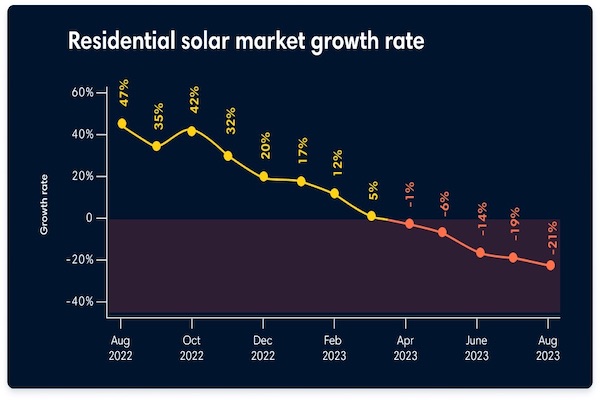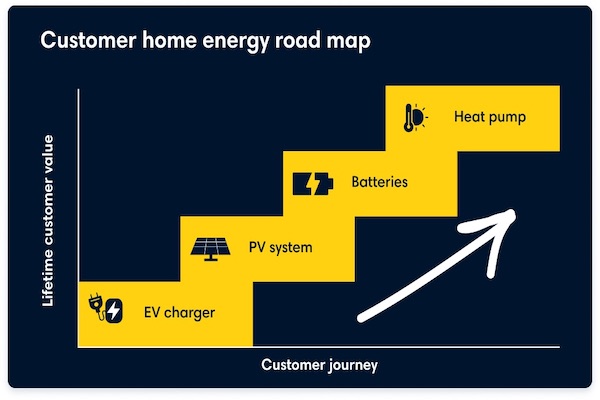Surviving the Solarcoaster: The 4 strategies residential installers need
Before 2023, one solar installer out of Texas was living the dream — in business over 12 years, he had grown his company almost entirely on referrals and inbound leads.
But then this year hit. Suddenly, this Texan installer saw other solar companies go bankrupt and their own steady stream of inbound leads slowed to a trickle. Instead of going under, however, he and his team pivoted, adopting new marketing and sales strategies that have allowed them to keep pre-2023 top line revenues — even in this tough economic climate.

Despite the big win of the Inflation Reduction Act (IRA), residential solar has been plagued by major challenges this year (including bad actors, anti-solar state policies, and high interest rates) that led to a 20 percent decline in installation volume in Q3 compared to the year before.
Of these challenges, high interest rates hit the industry the hardest. Prior to this year, ultra-low interest loans fueled the massive growth in residential solar. In 2022, 75 percent of all residential solar was financed by loans. However, when interest rates started to rise, the financial calculus for consumers investing in solar changed. Solar companies that relied on strong sales growth to finance their business soon saw a cash crunch, and folded.
But as any veteran solar professional will tell you, this is the solarcoaster nature of the market; it will rebound. It’s just a matter of when, and if your business will be around to make the most of it. To help you, here are 4 strategies installers have used to shore up their business despite the challenges of this year.
Strategy 1: Create a multi-step energy plan for your customer
Solar customers used to want the biggest solar + storage system they could pack into a low-interest loan. But now, homeowners are much more hesitant to go all-in on all-encompassing home energy projects. It appears they’ve reverted to just dipping their toes into the world of solar.
There are pros and cons to this new reality. New sales may be smaller, but follow-on sales have accelerated. At least one solar installer has seen a clear rise in repeat customers within one calendar year, first installing solar and then adding batteries. What this means is that, rather than focusing on the initial transaction, sales should focus on customer lifetime value which can be several multiples of the initial sale.
To leverage this, your team needs to know how to build a home energy roadmap with their prospects, and approach the full selling process in stages. Your marketing team should also market around the multiple ways it’s possible to go solar. From a smaller initial system to an EV charger, not every person is going to choose the same gateway to solar.
Strategy 2: Partner with other players and vendors to scale your marketing
Just because you’re a local or regional installer doesn’t mean you can’t leverage the marketing power of national vendors. By co-marketing, you can radically grow your available marketing dollars to reach prospects.
Proving the old adage that a rising tide lifts all boats, manufacturers and distributors are realizing the need to participate in market creation. Now more than ever, they’re willing to partner and share advertising spend with solar installers. The benefit? The installer’s brand is still front-and-center, but the campaign itself is subsidized by these larger vendors. Given that this is a common strategy in other industries, expect it to grow within solar.

Strategy 3: Turn service into a profit center
The number of orphaned systems is growing, but what many installers don’t realize is that all of these orphaned systems can be another revenue stream.
A conversation overheard at RE+ is emblematic of the new solar landscape: One solar homeowner reached out to an installer by saying, “Something’s not working, but the company that installed my solar isn’t around anymore. Also, do you install EV chargers?”
Many installers think of service as a cost center, but there is money to be made if your team is equipped to capitalize on orphaned and older systems. Plus, to these orphaned customers, you’re their solar hero, and they’re your best bet for 5-star google reviews and referrals.
Strategy 4: Embrace third-party financing options
You’ve probably noticed the resurrection of third-party financing options (TPO) like PPAs and leases. Though they had previously fallen out of favor, TPOs are becoming more financially attractive compared to loans for many customers. Since these systems are not owned by the homeowners, they’re better options for customers with limited tax liability or those not wanting to be responsible for the O&M of the system.
In the coming years, organizations offering TPOs will also be the ones best able to leverage IRA adders — helping to keep down prices and fees.
More companies are offering TPOs. In order to make the most of this financing option, sales teams must learn how to sell TPOs, which are markedly different from loans, especially when it comes to the payments and homeowner responsibilities.
The current financing landscape has forced many solar companies to get creative or go out of business. However, these strategies prove that it’s still possible to build a resilient and profitable business. By updating your playbook now, you can overcome high interest rates and come out stronger when the market rebounds.
Scott Nguyen is CEO at Bodhi, a design-focused software platform that helps residential solar installers deliver amazing customer experiences.
Bodhi | www.bodhi.solar
Author: Scott Nguyen
Volume: 2023 November/December










.jpg?r=6153)

.gif?r=8645)